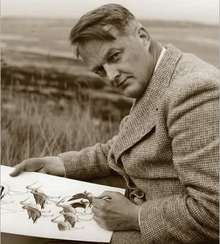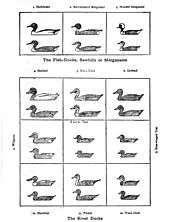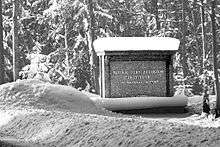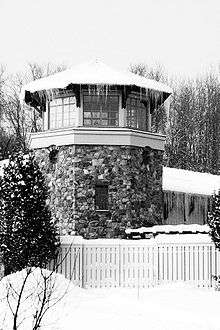Roger Tory Peterson
| Roger Tory Peterson | |
|---|---|
 | |
| Born |
August 28, 1908 Jamestown, New York |
| Died |
July 28, 1996 (aged 87) Old Lyme, Connecticut |
| Occupation | author, ornithologist, naturalist |
| Nationality | American |
| Subject | Birds |
| Notable works | Wild America, The Peterson Field Guides |
Roger Tory Peterson (August 28, 1908 – July 28, 1996) was an American naturalist, ornithologist, artist, and educator, and held to be one of the founding inspirations for the 20th-century environmental movement.[1]
Background
Peterson was born in Jamestown, New York, August 28, 1908. His father, Charles Peterson, was an immigrant from Sweden, coming to America as an infant. At the age of ten, C. Peterson lost his father to appendicitis, and he was sent off to work in the mills. After leaving the mills, he earned his living as a traveling salesman. His mother, Henrietta Badar, was an immigrant from Germany, at the age of four, growing up in Rochester, New York. She went to a teachers' college, and was teaching in Elmira, New York, when she met Charles. They married, and moved to Jamestown, a small, industrial city in south-west New York, where C. Peterson took a job at a local furniture factory. [2]
Career
Peterson's first work on birds was an article "Notes from field and study" in the magazine Bird-lore, where he recorded anecdotally two sight records from 1925, a Carolina wren and a titmouse.[2]

In 1934 he published his seminal Guide to the Birds, the first modern field guide, which sold out its first printing of 2‚000 copies in one week, and subsequently went through 6 editions. One of the inspirations for his field guide was the diagram of ducks that Ernest Thompson Seton made in Two Little Savages (1903).[3] He co-wrote Wild America with James Fisher, and edited or wrote many of the volumes in the Peterson Field Guide series, on topics ranging from rocks and minerals to beetles to reptiles. He developed the Peterson Identification System, and is known for the clarity of both his illustrations of field guides and his delineation of relevant field marks.[4][5]
Paul R. Ehrlich, in The Birder's Handbook: A Field Guide to the Natural History of North American Birds (Fireside. 1988), said this about Peterson:
In this century, no one has done more to promote an interest in living creatures than Roger Tory Peterson, the inventor of the modern field guide.[6]

Peterson received every major American award for natural science, ornithology, and conservation, as well as numerous honorary medals, diplomas, and citations from America and elsewhere, including the Linnaean Society of New York's Eisenmann Medal, the United States Presidential Medal of Freedom and the Order of the Golden Ark of the Netherlands. In 1977, he was honored by selection by the two Swedish District lodges of the Vasa Order of America to be Swedish-American of the Year. He received nominations for the Nobel Peace Prize and honorary doctorates from numerous American universities.[7]
He died in 1996 at his home in Old Lyme, Connecticut. Roger Tory Peterson was cremated following his death. A portion of his ashes were spread on and round Great Island near Old Lyme, Connecticut. Another portion of his ashes are buried in the Old Lyme Cemetery also known as the Duck River Cemetery. A third portion of his ashes is inurned in the Pine Hill Cemetery, Falconer, New York in the family plot where his father and paternal grandparents are buried.
The Roger Tory Peterson Institute of Natural History in Jamestown, New York is named in his honor.[8] In 2000, the American Birding Association established the Roger Tory Peterson Award for Promoting the Cause of Birding.[9] A critically lauded biography, Birdwatcher: The Life of Roger Tory Peterson (The Lyons Press. 2008) by Elizabeth Rosenthal, was published for the centennial anniversary of Peterson's birth.
See also
Publications
- A Field Guide to the Birds of Eastern and Central North America (Houghton Mifflin‚ fifth edition. 2002, earlier editions 1934‚ 1939‚ 1941‚ 1947‚ 1980‚ 1994)
- The Field Guide Art of Roger Tory Peterson (Easton Press, 1990. 2 volumes)
- Save the Birds with Antony W. Diamond‚ Rudolf L. Schreiber‚ Walter Cronkite (Houghton Mifflin‚ 1987)
- Peterson First Guide to Wildflowers of Northeastern and North-central North America (Houghton Mifflin‚ 1986)
- Peterson First Guide to Birds of North America (Houghton Mifflin‚ 1986)
- The Audubon Society Baby Elephant Folio with Virginia Peterson (Abbeville Press‚ 1981)
- Penguins (Houghton Mifflin‚ 1979)
- Birds of America (National Audubon Society‚ 1978)
- A Field Guide to Mexican Birds with Edward Chalif (Houghton Mifflin, 1973, Spanish translation‚ Editorial Diana‚ 1989)

- A Field Guide to Wildflowers of Northeastern and North-central North America with Margaret McKenny). (Houghton Mifflin‚ 1968)
- The World of Birds with James Fisher (Doubleday‚ 1964)
- A Field Guide to the Birds of Texas and Adjacent States (Houghton Mifflin‚ 1960, revised 1963)
- A Bird-Watcher's Anthology (Harcourt Brace‚ 1957)
- Wild America with James Fisher (Houghton Mifflin, 1955)
- A Field Guide to the Birds of Britain and Europe with Guy Mountfort, and P.A.D. Hollom (William Collins, 1954)
- 1965 edition: revised and enlarged in collaboration with I.J. Ferguson-Lees and D.I.M. Wallace
- 1971 impression: ISBN 0-00-212020-8
- 2004 edition: ISBN 978-0-00-719234-2
- Wildlife in Color (Houghton Mifflin‚ 1951)
- How to Know the Birds (Houghton Mifflin‚ 1949)
- Birds Over America (Dodd, Mead and Company‚ 1948, revised 1964)
- A Field Guide to Western Birds (Houghton Mifflin‚ 1941, revised 1961‚ 1990)
- The Audubon Guide to Attracting Birds with John H. Baker (National Audubon Society‚ 1941)
References
- ↑ "''Roger Tory Peterson‚ Biography'' (Houghton Mifflin Harcourt)". Houghtonmifflinbooks.com. Retrieved 2014-02-24.
- 1 2 Carlson, Douglas (2007-10-01). "Table of Contents and Excerpt, Carlson, Roger Tory Peterson". University of Texas Press. p. 308. Retrieved 2011-02-11.
- ↑ Carson, Douglas (2012). Roger Tory Peterson: A Biography. University of Texas Press. p. 5.
- ↑ "''Roger Tory Peterson'' (The New York Times)". Valdosta.edu. 1996-08-04. Retrieved 2014-02-24.
- ↑ Roger Tory Peterson (Wilsonart Laminate) Archived January 13, 2010, at the Wayback Machine.
- ↑ Ehrlich, Dobkin and Wheye, 1988
- ↑ Roger Tory Peterson (Vasa Order of America)
- ↑ Roger Tory Peterson Institute of Natural History
- ↑ "American Birding Association Awards". Retrieved 27 August 2012.
Other sources
- Carlson, Douglas. Roger Tory Peterson: A Biography (The University of Texas Press. 2007) ISBN 978-0-292-71680-3.
- Devlin, John C. and Grace Naismith. The World of Roger Tory Peterson – An Authorized Biography. (New York Times Books. 1977) ISBN 0-8129-0694-2
- Ehrlich, Paul R., David S. Dobkin and Darryl Wheye. The Birder's Handbook: A Field Guide to the Natural History of North American Birds (Fireside. 1988) ISBN 0-671-65989-8.
- Johnson, J. (2008). "Naturalist and Legend: Roger Tory Peterson". New York State Conservationist. 63 (August): 2–7. ISSN 0010-650X.
- Mountfort, G. (1996). "Obituary: Roger Tory Peterson (1908–1996)". British Birds. 89: 544–545. ISSN 0007-0335.
- Rosenthal, Elizabeth J. Birdwatcher: the Life of Roger Tory Peterson (The Lyons Press. 2008) ISBN 978-1-59921-294-4.
External links
- Roger Tory Peterson Institute official website
- Peterson Field Guides
- Roger Tory Peterson Birding Festival